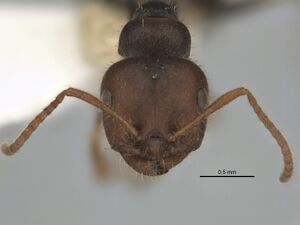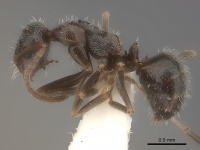Melophorus mjobergi
| Melophorus mjobergi | |
|---|---|

| |
| Scientific classification | |
| Kingdom: | Animalia |
| Phylum: | Arthropoda |
| Class: | Insecta |
| Order: | Hymenoptera |
| Family: | Formicidae |
| Subfamily: | Formicinae |
| Tribe: | Melophorini |
| Genus: | Melophorus |
| Species group: | biroi |
| Species complex: | biroi |
| Species: | M. mjobergi |
| Binomial name | |
| Melophorus mjobergi Forel, 1915 | |
Melophorus mjobergi is very common in the Pilbara and Kimberley regions of WA, where it was among the most abundant Melophorus taken by the principal author in roadside collections. Collections were made in a variety of habitats including sand plain, red clay soil, grassy woodland, tall grass over light soil, the crest of a small sand dune, a station rubbish dump with much woody litter and grasses, and on a grassed road verge near a petrol station. This considerably augments previous information on the species: as with so many other Melophorus, earlier collectors omitted to record any data for this small ant apart from the fact that several specimens were collected in pitfall traps and one worker from Avon Downs Stn, NT, was taken ‘on flowers’. (Heterick et al. 2017)
Identification
Heterick et al. (2017) - Melophorus mjobergi can be placed in the Melophoprus biroi species-group on the basis of characters of the clypeus, propodeum, mandible and palps. The species is also placed in the M. mjobergi clade (within the Melophoprus biroi species-complex) because of characters best seen in the major worker. These include (seen in full-face view) the deeply recessed area around the frontal carinae and medial sector of clypeus visible in the major and media workers, the psammophore generally placed on or just above anterior margin of clypeus, and the minor workers hairy with bristly, short erect setae. In Melophorus mjobergi the head of all workers is microreticulate and moderately shining to matt and the setae-bearing sockets on the head of the major worker are impressed so as to appear as small, oval depressions. In full-face view, the antennal carina of the major worker is limited to a flange around the antennal insertion, a weak ridge representing the posterior extension of carina is strongly concave posteriad. This will differentiate this ant from Melophorus compactus. Also, unlike M. compactus, the eye of the minor worker is placed anteriorly on head capsule and is moderate in size (in profile, eye length ≈ 0.25× length of side of head capsule). Melophorus mjobergi is very similar to Melophorus postlei but the appressed setae in all workers is loose and relatively thick and does not obscure the underlying cuticle, which is moderately shining in appearance.
Melophorus mjobergi is difficult to distinguish from M. postlei, but is shiny rather than matt in appearance and the appressed setae on the mesopleuron and gaster are more widely separated and do not obscure the underlying cuticle. On a five-gene and COI gene trees the two taxa are distinctly separate although closely related.
Keys including this Species
Distribution
The known distribution of the species is QLD, SA (TERC – one locality) and WA.
Distribution based on Regional Taxon Lists
Australasian Region: Australia (type locality).
Distribution based on AntMaps
Distribution based on AntWeb specimens
Check data from AntWeb
Countries Occupied
| Number of countries occupied by this species based on AntWiki Regional Taxon Lists. In general, fewer countries occupied indicates a narrower range, while more countries indicates a more widespread species. |

|
Estimated Abundance
| Relative abundance based on number of AntMaps records per species (this species within the purple bar). Fewer records (to the left) indicates a less abundant/encountered species while more records (to the right) indicates more abundant/encountered species. |

|
Biology
Melophorus mjobergi has been collected generally throughout the SWBP. (Heterick 2009)
Castes
Worker
   
| |
| Worker (major). . | Owned by Australian National Insect Collection. |
   
| |
| Worker (minor). . | Owned by Australian National Insect Collection. |
Phylogeny
| Melophorus |
| ||||||||||||||||||||||||||||||||||||
Based on Heterick et al., 2017. Only selected species groups/complexes are included.
Nomenclature
The following information is derived from Barry Bolton's Online Catalogue of the Ants of the World.
- mjobergi. Melophorus mjobergi Forel, 1915b: 88 (w.) AUSTRALIA. Combination in M. (Erimelophorus): Wheeler, W.M. 1935c: 71.
Unless otherwise noted the text for the remainder of this section is reported from the publication that includes the original description.
Description
Worker
Heterick et al. (2017) - (n = 8): CI 89–89; EI 29–30; EL 0.16–0.17; HL 0.63–0.65; HW 0.56–0.58; ML 0.86–0.88; MTL 0.57–0.60; PpH 0.08–0.10-; PpL 0.35–0.36; SI 136–137; SL 0.76–0.79.
Minor. Head. Head approximately oval with straight sides; posterior margin of head strongly convex; frons matt or with weak sheen, microreticulate or microreticulate-shagreenate; pilosity of frons a mixture of a few well-spaced, erect setae interspersed with appressed setae only, or consisting of appressed pubescence, with many short, unmodified, erect setae. Eye moderate (eye length 0.20–0.49 length of side of head capsule); in full-face view, eyes set above midpoint of head capsule; in profile, eye set around midline of head capsule; eyes elliptical or slightly reniform. In full-face view, frontal carinae straight, divergent posteriad; frontal lobes straight in front of antennal insertion. Anteromedial clypeal margin broadly and evenly convex; clypeal psammophore set at or just above anterior clypeal margin; palp formula 6,4. Five mandibular teeth in minor worker; mandibles triangular, weakly incurved; third mandibular tooth distinctly shorter than apical tooth and teeth numbers two and four; masticatory margin of mandibles approximately vertical or weakly oblique. Mesosoma. Integument of pronotum, mesonotum and mesopleuron moderately shining and shagreenate throughout; anterior mesosoma in profile smoothly rounded anteriad, thereafter pronotum and whole of mesonotum flattened and on same plane as propodeum; appearance of erect pronotal setae short, (i.e., longest erect setae shorter than length of eye) and unmodified; in profile, metanotal groove shallow, indicated mainly by an angle; propodeum shining and shagreenate; propodeum angulate, propodeal angle blunt; length ratio of propodeal dorsum to its declivity between 1:1 and 1:2; erect propodeal setae present and sparse to moderate (1-12); appressed propodeal setulae long and closely aligned, creating pubescence, or long, each reaching setae behind and in front, but not forming pubescence; propodeal spiracle situated on or beside declivitous face of propodeum, and longer (length ≥ 0.50 × height of propodeum). Petiole. In profile, petiolar node squamiform; in full-face view, shape of petiolar node uniformly rounded; node shining and distinctly shagreenate-microreticulate. Gaster. Gaster weakly shining with indistinct shagreenation; pilosity of first gastral tergite consisting of well-spaced, short, thick, erect setae over long, closely aligned, whitish, appressed setae. General characters. Colour concolorous light brown.
Major. Head. Head square; posterior margin of head planar or weakly concave; cuticle of frons matt or with weak sheen, with many fine, longitudinal striolae anteriad; pilosity of frons a mixture of many short, erect, bristly setae interspersed with regularly spaced appressed setae. Eye small (eye length < 0.20 × length of head capsule); in full-face view, eyes set above midpoint of head capsule; in profile, eye set anteriad of midline of head capsule; eyes elliptical. In full-face view, frontal carinae distinctly concave; frontal lobes curved toward antennal insertion. Anterior clypeal margin narrowly convex and protruding anteromedially, clypeal margin entire or weakly indented; clypeal psammophore set at or just above anterior clypeal margin; palp formula 6,4. Four mandibular teeth in major worker; mandibles triangular, weakly incurved; third mandibular tooth distinctly shorter than apical tooth and teeth number two, but longer and narrower than basal tooth; masticatory margin of mandibles approximately aligned vertically or weakly oblique. Mesosoma. Integument of pronotum, mesonotum and mesopleuron matt or with weak sheen and microreticulate throughout; anterior mesosoma in profile convex anteriad, straight thereafter; erect pronotal setae short, (i.e., shorter than length of eye) and unmodified; in profile, metanotal groove shallow, narrowly V-shaped; propodeum matt or with a weak sheen and microreticulate; propodeum smoothly rounded or with indistinct angle; propodeal dorsum and declivity confluent; erect propodeal setae present and abundant (at least a dozen); no appressed propodeal setae, but a few relatively long decumbent setae present, not creating pubescence; propodeal spiracle situated on or beside declivitous face of propodeum, and longer (length greater than 0.50 × height of propodeum). Petiole. In profile, petiolar node narrowly squamiform; in full-face view, shape of petiolar node tapered with blunt vertex; node shining and superficially microreticulate. Gaster. Gaster shining with indistinct shagreenation; pilosity of first gastral tergite consisting of a mixture of curved, erect and semi- erect setae and decumbent setae that are not sufficiently close to form pubescence. General characters. Colour uniformly light olive brown.
Type Material
Heterick et al. (2017) - Syntype (likely) minor worker, Broome, Western Australia, Australian National Insect Collection (examined: ANIC specimen The minor worker lacks Forel’s red ‘typus’ label, but possesses a handwritten label with ‘type’ on it and very probably belongs to the series of eight workers inspected by Forel when he described this species, despite the presence of a ‘co-type’ label.) Also examined: Images of syntype minor worker, Broome, Western Australia Musee d'Histoire Naturelle Genève, Naturhistoriska Riksmuseet (AntWeb images of MHNG specimen CASENT0909819, images of NHRS specimen [image no. NHRS-HEVA 000003949]). The California Academy of Sciences ant is accompanied by a red ‘typus’ label, but the NHRS specimen is accompanied by a handwritten label only.
- Syntype, 1 worker, Broome, Western Australia, Australia, Australian National Insect Collection.
References
- Borowiec, M.L., Moreau, C.S., Rabeling, C. 2020. Ants: Phylogeny and Classification. In: C. Starr (ed.), Encyclopedia of Social Insects (doi:10.1007/978-3-319-90306-4_155-1).
- Forel, A. 1915b. Results of Dr. E. Mjöbergs Swedish Scientific Expeditions to Australia 1910-13. 2. Ameisen. Ark. Zool. 9(1 16: 1-119 (page 88, worker described)
- Heterick, B. E. 2009a. A guide to the ants of South-western Australia. Records of the Western Australian Museum, Supplement 76: 1-206. Part 2.
- Heterick, B.E. 2021. A guide to the ants of Western Australia. Part I: Systematics. Records of the Western Australian Museum, Supplement 86, 1-245 (doi:10.18195/issn.0313-122x.86.2021.001-245).
- Heterick, B.E. 2022. A guide to the ants of Western Australia. Part II: Distribution and biology. Records of the Western Australian Museum, supplement 86: 247-510 (doi:10.18195/issn.0313-122x.86.2022.247-510).
- Heterick, B.E., Castalanelli, M., Shattuck, S.O. 2017. Revision of the ant genus Melophorus (Hymenoptera, Formicidae). ZooKeys 700, 1–420 (doi: 10.3897/zookeys.700.11784).
- Wheeler, W. M. 1935c. Myrmecological notes. Psyche (Camb.) 42: 68-72 (page 71, Combination in M. (Erimelophorus))
References based on Global Ant Biodiversity Informatics
- Taylor R. W. 1987. A checklist of the ants of Australia, New Caledonia and New Zealand (Hymenoptera: Formicidae). CSIRO (Commonwealth Scientific and Industrial Research Organization) Division of Entomology Report 41: 1-92.

